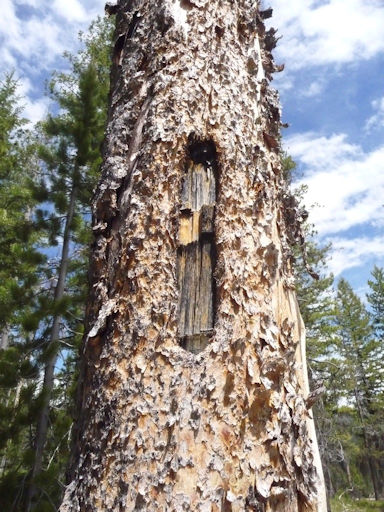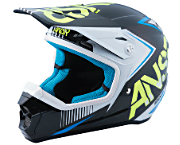
© 2019 by Bill Uhl
This article can help all-terrain vehicle (ATV), snowmobile and motorcycle dirt bike riders and mountain bikers stay safe during off-road vehicle (OHV) riding experiences. Most people don’t give adequate attention to a very old-fashioned safety training marker: blaze marks. Most recreational safety training classes fail to point out how blaze marks can sometimes prevent accidents and injuries when machine operators become lost or disoriented.
CREATION OF THIS OFF-ROAD VEHICLE SAFETY TRAINING MARKER
At one time in U.S. history, forest trails were our nation’s “highway system”. As people began using public lands in more diverse ways, from commerce to recreation, the need for off-highway vehicle (OHV) safety training markers emerged. Although the process wasn’t standardized in the early days, motorcycle dirt bike riders, ATV riders, snowmobile operators, off-road bicyclists and hikers marked trails so others could follow their path.
Of course, the amount of use varied greatly according to the need for access and the time of year. As people moved into new areas, each next generation of users needed a way to find and use the most direct and desirable routes (paths of least resistance) to get from point A to point B.
MARKINGS THAT COULD MAKE TRAVEL SAFER AND EASIER
Originally, markings could be as simple as a pile of rocks (often called a cairn) that served as a signal to find the next pile of rocks. Sometimes a traveler would find a pole placed in the center of a pile of rocks to help make a specific location (a marker) stand out in a landscape. Other examples include a single rock sitting on top of a larger rock that would not have been placed that way by nature, a hatchet mark in the side of a tree or a picture graph indicating which way to go.
Native Americans used to burn large scars in the shape of a pyramid into the side of a prominent tree. Members of a tribe who traveled long distances knew to search for a wound in the bark of a tree.
Trappers, miners and sheep herders used a single hatchet mark about 4 inches by 4 inches. The U.S. Forest Service eventually adopted a standard of two blaze marks per tree. The first mark was to be 4×4 inches. A second blaze mark measuring 4×8 inches was placed below the first mark.
As the video illustrates, you’ll often see this type of blaze mark in both live and dead trees, including trees later burned in forest fires. The way blaze marks heal depends on the type of tree and the time of year they are created. This means there are significant variations regarding what to look for.
In some situations, artificial markers in the shape of a diamond are nailed to the side of trees. These markers don’t last long. In fact, they must be constantly redone. Unfortunately, artificial markers do not blend into the countryside. They look out of place in nature, where a true blaze mark can last 75 plus years while blending into a tree’s surroundings. I’ve included some examples in the attached video.
BLAZE MARKS AS AN OFF-ROAD RIDING SAFETY TRAINING TOOL
When done correctly, except for the artificial markers, the above markers can last a surprisingly long time. I’ve found marks that date back to the 1800s that are still doing their job of marking a route. As a private contractor hired to conduct off-road trail design and construction projects, I created blaze marks that still function well after 45 years. Click here to learn more about designing and constructing trails for ATVs, snowmobiles, motorcycle dirt bikes and mountain bicycles.
More than once, when serving as a Court-Qualified Expert Witness and Off-Highway Vehicle Senior Safety Trainer, I’ve placed a rock on top of a bigger rock to mark a route. Upon returning to the area years later, I’d find the rock marker continuing to do its job, marking a route and functioning as a safety training tool.
If a blaze mark has been created correctly, when a traveler stands at a tree with the marked area behind them, he’ll be looking in the direction the trail goes next. Two blaze marks reduce the possibility of chance and related travel dangers or safety errors. When one blaze mark validates another, it is less likely that one mark is merely a wound created by a falling rock or a deer rubbing up against the tree to get velvet off its horns.
Here’s another important thing to observe: Ideally, the opposite side of the tree will have a blaze mark pointing in the direction the traveler just came from. Of course, depending on the size of the tree, I would blaze only one side of a tree, especially a small tree, to give it time to heal before blazing the other side the following year. All in all, every blaze is like a corner that marks all the twists and turns we find in trail adventures.
MORE BLAZE MARK OFF-ROAD RIDING SAFETY TIPS
Imagine being in an unfamiliar area when the weather changes and visibility drops to almost zero while the trail crosses one meadow after another. It might even be snowing. Without correctly placed blaze marks, you’ll likely be disoriented with no idea which way to go to get out of the back country. On the other hand, with a correctly placed blaze mark, you can walk or ride with the blaze mark at your back side in a direction someone else already thoughtfully determined to be the most direct or easiest path to the next blaze mark on the trail.
Another clue to sometimes follow is to walk or ride the edge of a meadow. If the trail actually crossed the meadow, you can look for a blaze mark on the far side of the meadow. (Of course, the trail may have changed direction, veering off at an angle to the meadow.)
This introduces the next point to consider. The less a trail is used, the more users must rely on blaze marks to guide them. I do want to emphasize that you cannot just follow a trail tread because it can disappear into tall grasses at certain times of the year. Sometimes multiple trail treads link at a common junction because the area is a main migratory route for big game animals. They may have a different destination in their minds than where you want to travel.
As blaze marks age, they take on different shapes and appearances, such as a wound in a tree’s bark growing shut. I’ve found blazes that were so old that the only remaining sign was a discoloration in the bark where the blaze had been located. I remember one old blaze that could only be seen when the sun was setting and the light was just right.
In order to gain the most value from blaze marks, train yourself to see what is really in front of you, instead of what you’re used to seeing. A qualified safety trainer can help you learn everything you need to know so you can avoid unnecessary accidents and personal injuries.
LEARN MORE ABOUT USING BLAZE MARKS AS A SAFETY TOOL
As you watch the video on this web page illustrating different ages of blaze marks and multiple ways to mark trails, notice there are both rules and a lack of rules. This is because trails are created and marked by people with highly diverse backgrounds and understanding regarding how and what needs to happen to correctly mark a trail. Click here to discover many more safety tips regarding safety training for riding all-terrain vehicles (ATVS), utility vehicles (UTVs / side by sides, SxS), ROVs, OHVs, snowmobiles, motorcycle dirt bikes, off-road bicycles, off-road vehicle trail building and guided tours.
NOTE: This article is not intended to be all inclusive. It is designed to provide a foundation for the reader to learn from.
Bill Uhl is a Safety Trainer, Trail Builder and Court-Qualified Expert Witness for cases involving all-terrain vehicles (ATVs), utility vehicles (UTVs / side by sides, SxS), ROVs, OHVs, snowmobiles, motorcycle dirt bikes, dual sport bikes, off-road bicycles trails and guided tours. Uhl has completed over 75 cases while serving as an Expert Witness, working for both plaintiffs and defendants, including providing trial testimony. Click here now for more information about Mr. Uhl.


